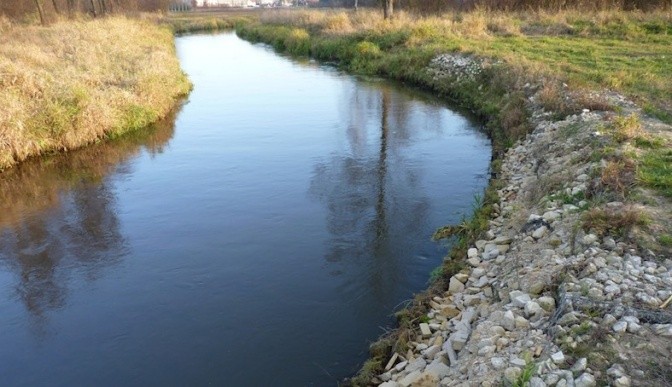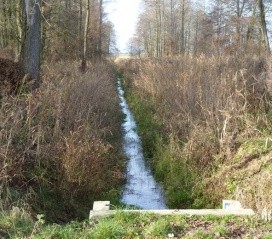How to kill a nation’s rivers. I visited Poland, where they are doing just that. It is a terrifying lesson for the many other nations worried about floods and determined to engineer their way to a solution. Thailand, among others, please listen. There is a better way.
 The Drzewiczka river in Poland has been dredged and the bank has been cleared of vegetation and replaced with rocks, which some doubt provides any flood protection. Photo: Fred Pearce
The Drzewiczka river in Poland has been dredged and the bank has been cleared of vegetation and replaced with rocks, which some doubt provides any flood protection. Photo: Fred PearceIn the past four years, Polish river engineers have culverted, landfilled, dredged, straightened and concreted the banks of a staggering 16,000 kilometres of their rivers – about a fifth of all the country’s rivers.
The declared purpose is to prevent floods. This splurge of Stalinist engineering, largely funded by the European Union, is built on the assumption that by rushing water towards the sea you can stop land flooding. It’s not true. This is discredited engineering, though still widely practiced round the world. The normal result of this approach is to create floods.
Major flood disasters in recent years, from the Mississippi to the Rhine, have convinced a new generation of engineers that the “rush-it-to-the-sea” approach does not work. It may defend the immediate vicinity, but sends a rush of water downstream, where it will find the weakest point in flood defences, venting nature’s wrath with even greater force.
Modern river engineers increasingly favour an alternative approach – holding floodwaters on the land for as long as possible so they can enter rivers and head for the sea later, when the crisis is past. In many countries this has another benefit: the water is available for later use, during dry seasons and droughts.
River engineering
 This concrete-lined canal, intended to protect local farms from floods, has replaced the Moszczanka river's natural course. Photo: Fred Pearce
This concrete-lined canal, intended to protect local farms from floods, has replaced the Moszczanka river's natural course. Photo: Fred Pearce
In Poland, I went southwest of Warsaw to one of the many areas suffering a blitz of river engineering. Marcin Kazmierczak, an environmental engineer by profession and conservation activist in his spare time, took me to see the River Moszczenica. Down in a valley among a line of trees, the natural course of the river suddenly disappeared. It had been replaced with a straight concrete-lined canal.
“All along this stretch, they simply landfilled the old river,” Kazmierczak said. “This was my favourite spot, the most beautiful part of the river. Before this engineering, it had beavers, otters and weasels. But they are gone now.” The canal was intended to protect local farms from floods, he said. But in the steep valley, it was hard to see who would be protected.
He showed me maps of the old meandering river. It was shorter now, and without undergrowth to impede the flow. The water would certainly go downstream faster. But this was crazy hydrology. “Regulating these little rivers increases the risk of floods on the bigger rivers downstream, including in cities like Warsaw,” says my guide, Przemek Nawrocki, a veteran campaigner with WWF in Poland.
We drove on to the Drzewiczka river by the village of Ogonowice, where the natural river has been dredged and the bank cleared of vegetation and covered in rocks. Tree roots that stabilise the bank were cut down to make way for the stone rip-rap. Was this protecting the village from floods? Nawrocki thought not. It was using EU money to provide jobs for local engineers.
A global trend
These were just two places among thousands. In just five years, Poland has used tens of millions of Euros provided to help it meet the EU Water Framework Directive targets for making rivers cleaner, more natural and more resilient to floods. But the result will be the exact opposite: rivers that are less natural and probably more vulnerable to floods.
The politics of Poland’s rush to cover its rivers in concrete may be local. But the issue is global. Many senior river engineers round the world were trained in old ways – to follow the dictum of rushing flood water to the sea. And whenever they can find the money for their work, that is what they do.
There is likely to be more money, in future, as the world wakes up to the fact that climate change is making weather more extreme and the risks of both floods and droughts more likely. Thailand, for instance, is currently embarking on an $11 billion programme of large-scale engineering to help its rivers discharge heavy monsoon rains into the ocean.
Many say this is folly. It will worsen the floods, but also worsen the drought years. And neither is necessary.
Solution: store flood water for future use
Vladimir Smakhtin, theme leader on water availability at IWMI, says flood waters are potentially a hugely valuable resource, and should not be squandered with engineering schemes to get rid of them. The trick is to store that water for future use. One technique for doing this is to use flood waters to recharged underground water reserves. Another is to rip out the linings from irrigation canals. Infiltration water is not lost, simply stored underground.
Smakhtin, with IWMI’s Paul Pavelic and others, has investigated the potential for this in Thailand, especially on the Chao Phraya river, which was a main cause of massive flooding in Bangkok three years ago. Instead of trying to rush the river’s flows to the sea during floods, they should be held back for future use.
The researchers say a quarter-million hectares of extra farmland could be irrigated if flood flows on the Chao Phraya were captured and stored underground during the one year in four when floods threaten. Paying upstream farmers to capture the excess flow and let it infiltrate into the ground could reduce flooding downstream, while recharging groundwaters. Smallholder farmers doing rain-fed farming in the dry season would gain especially.
Almost any monsoon river could be adapted in this way. If India harvested a quarter of its runoff during the short monsoon season, it could increase water available year-round by 50 per cent.
Cities plagued by floods could do the same thing. In Berlin new developments are required to have “porous” roads and parking areas, so when it rains the water percolates underground rather than overwhelming flood channels and rivers.
Flood waters, hydrologists argue, are both too dangerous and too valuable to be rushed to the sea. We badly need flood engineers to catch up.












Comments
To my mind the real scoop is that the principles of ‘water sensitive urban design’ that are being followed nowadays in the more advanced EU counties and other western countries aren’t being followed in Poland by the sound of it. In Australia, where I’m from, the concrete channels built in the 50s to 70s are being taken out and replaced by wetlands and more natural looking watercourses which still provide flood control + many other benefits. Maybe its just the way things have to evolve?
Delaying flow of water into the sea is a very basic river engineering. River engineering more of a nature science and must focus on the very nature of water natural hydraulics. Providing storage - both underground and above ground levels - along river channels is the best way of mitigating floods along river channels.
Surely the term 'river engineering' is an oxymoron? Apart from this example of nonsense being practiced on Poland using pubic money, there more absurd examples - the discharge of the SyrDarya into the Aral Sea is one,. With World Bank funds the Govt there has undertaken questionable measures to race the flow of the rivers to a specially enclosed part of the Aral Sea - the new water circulation (or non circulation) has left the 'lake' as a toxic pool. Significant efforts to try to get governments to adopt 'managed aquifer recharge' are being made by the International Association of Hydrogeologists. More is needed - much more - even in enlightened countries, 'river engineering' has got to be totally re configured into catchment management - thus widening the focus from the channel of the river to its whole catchment.
The wasteful and destructive practices described in this excellent article are taking place around the globe with equally devastating consequences. However, the issue is not technical, but political. The lack of good governance, as indicated by the seeming inability of local conservation organizations or other governmental agencies to effectively stop these engineering debacles , is the commonality across jurisdictions where these projects take place . Transparent governmental decision-making in conjunction with effective non-governmental organizations able to use a system of enforceable environmental protection laws is a necessary step for Poland if any of the nation's natural landscapes are to remain.